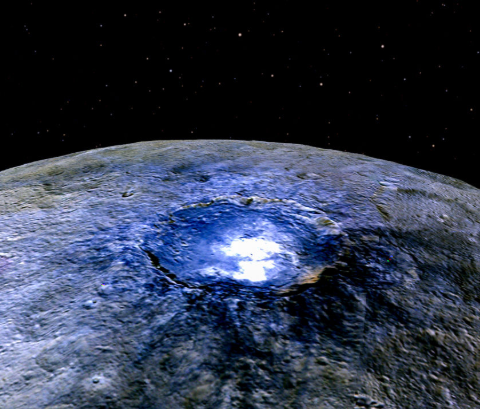Light shed on distant Ceres
 Findings from the Dawn spacecraft suggest that the dwarf planet Ceres - the largest known object in our asteroid belt - is an ocean world that may be geologically active.
Findings from the Dawn spacecraft suggest that the dwarf planet Ceres - the largest known object in our asteroid belt - is an ocean world that may be geologically active.
A suite of seven new scientific papers detail the observations from the second extended Dawn mission to Ceres.
The findings suggest that Ceres is an ocean world and may have been geologically active in the recent past.
The Dawn spacecraft orbited Ceres from 2015 to 2018, before it ran out of fuel.
In its final phase, the Dawn spacecraft orbited just 35 km above the surface of Ceres. It focused on the 20-million-year-old Occator crater, which had been shown earlier in the mission to exhibit bright deposits from brines coming from the interior.
The last data from Dawn has shown that there is an extensive brine reservoir deep beneath the Occator crater.
An international research team suggests that the reservoir could have been mobilised by the impact that created the crater, which contributed to the formation of bright salt deposits on the planet’s surface.
One of the new papers reports the presence of hydrated chloride salts at the centre of Cerealia Facula, the biggest bright area in the centre of Occator crater.
As these salts dehydrate very quickly, the authors suggest that the brines may still be ascending, indicating that salty fluids could still exist in the interior of the dwarf planet.
Other papers explored the make-up of Ceres’s crust, and suggest that Ceres underwent a period of cryovolcanic activity starting around nine million years ago, and persisted until very recently.
Additionally, experts have shown that the mounds and hills in the Occator crater may have formed when impact-induced water flows froze. This suggests that cryo-hydrologic processes extend beyond Earth and Mars, and were active on Ceres in the geologically recent past.
Some of the data also suggests that water- and salt-rich mud-like impact melts are distinct from, and less expansive than, those on Mars, and that the various bright deposits in the Occator crater may have had different sources.








 Print
Print